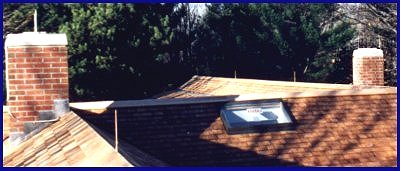Basic Principles of Lightning Protection
For further explanation, please see Details.
"Why would I want lightning to hit my home?" This question was asked by a perplexed home show attendee
when looking at our booth many years ago, and illustrates one of the more common myths surrounding
lightning rods: that they attract lightning. This myth is perpetuated by journalists who often use metaphors
such as "This person has been a lightning rod for trouble." While this phrase provides a graphic image,
it is incorrect because lightning rods do not "attract" lightning, nor do they repel lightning. Lightning rods
simply provide a contact point (above combustible building materials) for lightning that would strike the
building anyway. The energy is then safely dispersed onto low-resistance paths into the earth.
To explain another way, each lightning rod is connected to a grounding (earthing) system, just like the
television antennas that were on nearly every roof before cable TV and satellite dishes became
widespread. Modern buildings are already filled with grounded wires and grounded pipes, but these systems
are not designed, placed, or sized to handle lightning.
 Photo by Ed Lilley
Photo by Ed Lilley
|
Lightning can enter an unprotected home directly, through a window, by hitting a chimney or roof vent,
or indirectly, when some of the energy from nearby strikes follows wires (underground or aerial), pipes,
tree roots, etc. into the building, or the lightning energy is induced ("absorbed") into the building. Indirect
lightning is the most common form of lightning damage and can be prevented with properly installed surge
suppressors and extensive bonding of metallic bodies, which are then connected to the lightning rod system.
Carefully placed lightning rods, and the protection of nearby trees, will effectively handle the more destructive
direct lightning strikes.
The huge amounts of energy handled by the lightning protection system require multiple large, direct paths
into the earth, with adequate connections to the soil. These earth connections vary with soil type and
depth, and are accomplished with ground rods, ground plates, trenched cables, conductive concrete,
chemical grounds, and other methods that are typically far more involved and numerous than the simple
grounding provided for the building's electrical system. Careful design and installation of the system,
unique to each building and soil type, is the key to a lightning rod system that will provide many years
of protection, safety, and peace of mind.
Before investing in lightning protection, you are encouraged to explore the Details page on this site
to learn how Priestley Lightning Protection goes beyond code requirements and beyond common practices
to provide unobtrusive, effective protection for cherished people and buildings, and the critical electronic
systems they depend on.

|